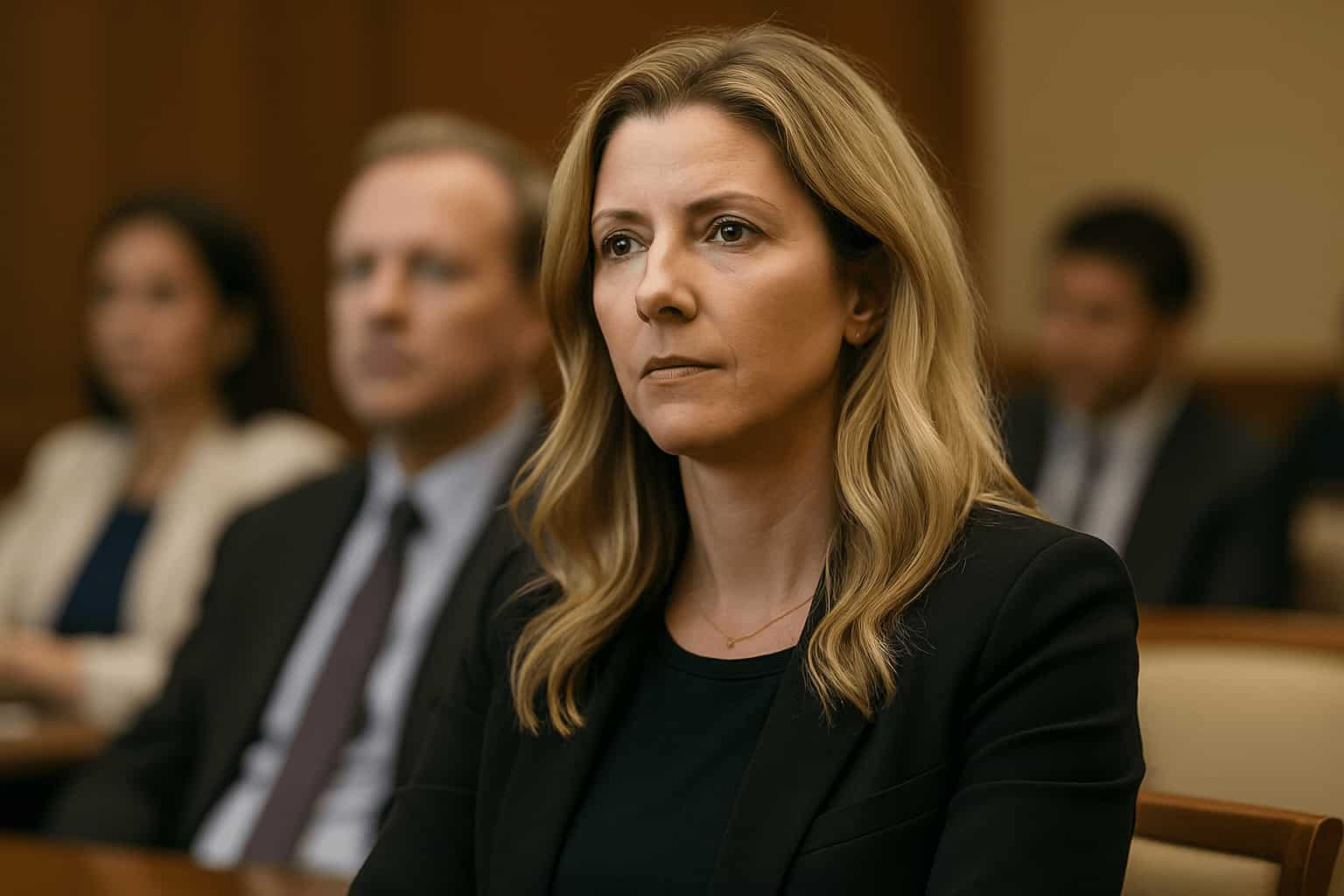Table of contents
Sara Blakely transformed a simple frustration with pantyhose into a billion-dollar empire. Her story represents one of the most compelling rags-to-riches narratives in modern entrepreneurship. Born in Clearwater, Florida, this self-made billionaire faced countless rejections before creating Spanx.
The daughter of an artist mother and trial attorney father, Blakely’s path was unconventional. She failed the LSAT twice, worked at Disney World, and spent seven years selling fax machines door-to-door. Each setback became a stepping stone toward her breakthrough. Her father’s unique approach to failure shaped her resilient mindset from childhood.
Today, Blakely’s net worth exceeds $1.1 billion. Her influence extends far beyond business. She became the first self-made female billionaire to sign the Giving Pledge. Her journey from struggling salesperson to global icon demonstrates extraordinary success from ordinary beginnings.
Early Life & Struggles
Childhood Dreams and Family Influence

Sara Treleaven Blakely entered the world on February 21, 1971, in Clearwater, Florida. Her mother, Ellen Ford, was an artist who encouraged creativity. Her father, John Blakely, worked as a trial attorney and introduced a revolutionary concept.
Every evening at dinner, he asked his children an unusual question: “What did you guys fail at this week?” This unconventional approach created a household where setbacks were celebrated rather than feared. If Sara and her brother had nothing to share, their father expressed disappointment.
He understood that many people become paralyzed by fear of failure. He wanted his children to try everything and push boundaries. This early conditioning taught Sara to define failure differently. Failure wasn’t achieving the wrong outcome, but not trying something she wanted to do.
The Blakely household fostered risk-taking and learning from mistakes. Sara’s father wanted his children to understand that behind every failure lay opportunity. This philosophy became the foundation of Sara’s approach to business and life.
Academic Pursuits and Early Setbacks
Throughout childhood and teenage years, Sara dreamed of becoming a trial attorney. She made all academic decisions with this goal in mind. She participated in debate teams and chose legal communications as her college major at Florida State University.
Her passion for law seemed natural, given her father’s profession. She immersed herself in studies and participated in debate competitions. Her professors recognized her potential, and her family supported her ambitions. Everything seemed perfect for a successful transition to law school.
However, life had different plans for Sara Blakely. When time came to take the LSAT, she encountered her first major setback. Despite strong academic performance, Sara struggled with the standardized test format. Her reading comprehension proved insufficient for the LSAT’s demanding requirements.
Additionally, she discovered trouble maintaining focus during extended testing periods. The combination of these challenges created significant obstacles to her legal career aspirations.
The LSAT Failures That Changed Everything
Sara’s first LSAT attempt resulted in devastating failure. The score eliminated any possibility of admission to reputable law schools. Rather than accepting defeat, Sara demonstrated resilience that would characterize her business career. She enrolled in intensive LSAT preparation courses.
For months, Sara studied with obsessive intensity. She devoted countless hours to practice tests and worked with tutors. Her family watched as she poured energy into mastering the test. The preparation period was grueling, but Sara remained convinced hard work would triumph.
When Sara retook the LSAT, results were even more crushing. She scored one point lower than her original test. This outcome seemed to mock her months of intensive preparation. The second failure was particularly devastating because it suggested fundamental mismatch between her abilities and legal education requirements.
Traumatized by this double failure, Sara questioned everything about her future. She wondered what the universe was trying to tell her. In a moment that would seem prophetic, she decided the universe was directing her toward a different path. Her response was characteristically unconventional: drive to Disney World and audition for Goofy.
The Disney World Detour

Sara’s decision to audition for Disney character roles represented escape from academic disappointments. Disney World seemed like the perfect antidote to recent failures. However, Disney only held character auditions periodically, so Sara needed temporary employment while waiting.
She secured a position at Epcot, wearing a brown polyester “space suit” and helping guests board attractions. Her job required walking on moving sidewalks for eight hours daily. She greeted visitors with the same message: “Hi, welcome to Disney, watch your step please.”
The work was repetitive and physically demanding. Sara encountered former classmates who were surprised to see her in an entry-level position. These encounters were awkward, with friends expressing confusion about her circumstances. Sara would sheepishly acknowledge recognition and quickly direct them to board rides.
When Sara finally auditioned for Goofy, she discovered another obstacle: too short for the costume. Disney officials offered her the chipmunk role instead. Company policies required employees to remain in initial positions before transferring. After three months of wearing polyester and repeating greetings, Sara reached her limit with “the happiest place on earth.”
Seven Years in Sales Hell
After leaving Disney World, Sara returned home to live with her mother. Without clear career prospects and needing income, she accepted a position selling fax machines door-to-door. The company “would hire anyone with a pulse,” reflecting challenging work and high turnover.
On her first day, Sara received minimal training. The company handed her a phone book and assigned four zip codes. They told her to “get out there and sell.” There were no potential customer lists, no warm leads, no established accounts. Sara had to generate 100 percent of her business through cold calling.
Sara’s daily routine became a grueling test of endurance. She would wake early and spend eight to nine hours driving around territories, making cold calls. The rejection rate was astronomical, with most doors slammed in her face. She witnessed business cards torn up weekly and received police escorts from buildings.
The psychological toll would have broken many people. Sara discovered unexpected resilience within herself. Rather than becoming discouraged, she gradually developed immunity to “no” and found humor in her situation. She realized she possessed unusual ability to find amusement in any circumstance.
During seven years in fax sales, Sara spent free time in “recreational thinking.” She would sit for hours, contemplating what she really wanted from life. Through introspection, she identified key insights: natural sales ability and desire for self-employment. She dreamed of selling something she created and cared about.
Turning Points
The Pantyhose Epiphany

After seven years of fax machine sales, Sara experienced what she called divine intervention. The breakthrough came through simple personal frustration that millions of women shared. The fashion industry had never adequately addressed this common problem.
Sara was preparing for an important event and wanted to wear fitted white pants. However, she faced a common dilemma: needing pantyhose’s slimming effect while wanting to wear open-toed sandals. Existing options were unsatisfactory, forcing women to choose between comfort, style, and confidence.
In creative desperation, Sara took scissors and cut feet off her pantyhose. This modification allowed her to enjoy slimming benefits while keeping feet bare for sandals. When she looked in the mirror, she experienced a “Thank you, God, this is my opportunity!” moment.
She immediately recognized she had stumbled upon a solution to widespread problems. Sara envisioned creating unique body shapewear that would be thin, comfortable, and invisible under clothes. The product would fill a market gap she had personally experienced.
This inspiration represented more than just a product idea. It was convergence of Sara’s sales experience, understanding of women’s needs, and entrepreneurial ambitions. She had spent years selling products she didn’t care about to people who didn’t want them. Now she had identified something she was passionate about.
The Secret Development Phase
Sara’s approach to developing her idea demonstrated wisdom gained from years of rejection. Rather than immediately sharing excitement with friends and family, she made a strategic decision: keep the idea completely secret for one year from anyone who couldn’t directly help.
This decision went against every entrepreneurial instinct. Natural tendency when struck by inspiration is seeking validation from everyone around you. Sara recognized that ideas are most vulnerable at conception, and discouraging remarks from loved ones could derail progress before sufficient investment.
During this secret phase, Sara worked tirelessly while maintaining her fax sales job. She spent evenings and weekends researching fabric types, studying patents, and learning about trademarks. She had no formal business education or fashion industry experience, but approached each challenge with determination.
Sara’s research process was exhaustive and methodical. She visited libraries, consulted patent attorneys, and studied the undergarment industry. She learned about fabric technologies, manufacturing processes, and regulatory requirements. This self-directed education was time-consuming but gave her comprehensive industry understanding.
Secrecy allowed Sara to develop her vision without external interference. She could refine concepts, consider approaches, and build confidence without defending against skepticism. By the time she was ready to share plans, she had invested enough that she wouldn’t turn back regardless of reactions.
The Family Revelation and Reaction

When Sara finally felt ready to reveal her idea, she had spent a full year researching and preparing. She had developed clear vision, understood market opportunity, and was emotionally invested enough to persevere despite criticism. The revelation came during a gathering where she announced her intention to create “footless pantyhose.”
The reaction was immediate and unanimous: everyone laughed hysterically. Friends and family thought she was joking, unable to believe someone with her intelligence would seriously consider such an idea. The laughter was well-intentioned, coming from people who loved her and wanted protection from perceived foolish ventures.
Criticism that followed was predictable and discouraging. Sara heard variations of concerns that crush many entrepreneurial dreams: “If it’s such a good idea, why haven’t big companies done it?” and “Major corporations will copy you immediately.” These objections reflected conventional wisdom about impossibility of competing against industry giants.
Sara’s response demonstrated confidence built during secret preparation. She acknowledged that friends and family might be right about challenges, but explained she had invested too much to turn back. Sara had spent a year researching, filing patents, developing names, and creating packaging. She was on her path with no intention of abandoning it.
This moment was crucial because it represented her first major commitment test. People closest to her were saying her idea was foolish and doomed. Less determined people might have been swayed by concerns and abandoned projects. Sara’s ability to maintain conviction proved she had mental toughness necessary for entrepreneurial success.
The Manufacturing Challenge
With concept developed and commitment solidified, Sara faced her next major challenge: finding manufacturers willing to produce her innovative product. This phase would test everything she learned about persistence, creativity, and face-to-face communication during sales years.
Sara began by calling hosiery mills throughout the southeastern United States. She explained her concept and requested assistance creating prototypes. Response was universally negative and often dismissive. Mill owners either laughed at her idea or explained it was fundamentally flawed and would never sell.
Rejections were particularly frustrating because Sara knew her idea had merit. She had personally experienced the problem her product would solve. She was confident millions of other women shared her frustration with existing options. However, she couldn’t convince industry professionals to take her seriously over the phone.
Drawing on cold-calling lessons, Sara decided face-to-face meetings would be more effective. She took a week off from fax sales and drove throughout North Carolina, visiting mills that had rejected her via telephone. Her strategy was simple but bold: sit in company lobbies and wait for opportunities to speak with founders or owners.
This approach required enormous patience and persistence. Sara would arrive at facilities early and wait for hours, hoping to catch executives between meetings. When she got five-minute opportunities to present concepts, she poured sales experience and passion into making strongest possible cases. Despite best efforts, in-person meetings initially produced same results as phone calls.
The breakthrough came two weeks after Sara’s North Carolina trip. She received an unexpected call from a Charlotte mill owner who said he had decided to help make her “crazy idea.” When she asked what changed his mind, his answer was simple and profound: “I have three daughters.”
Breakthrough Success
The Oprah Effect

Sara Blakely’s transformation from struggling entrepreneur to household name happened with stunning suddenness. In late 2000, after months of building her business one customer at a time, Sara received life-changing news: Oprah Winfrey had selected Spanx as one of her “Favorite Things.”
The Oprah Winfrey Show reached millions of viewers daily. It had almost magical ability to transform unknown products into overnight sensations. When Oprah endorsed something, her audience listened and acted. Sara understood this opportunity’s significance, but nothing prepared her for the response magnitude.
Within hours of the episode airing, Sara’s phone rang nonstop with orders from retailers and consumers nationwide. The Spanx website crashed under traffic volume. Sara found herself scrambling to fulfill orders that exceeded wildest projections. The exposure eliminated need for traditional advertising, launching Spanx into national consciousness with single television appearance.
Oprah’s endorsement validated Sara’s belief in her product. It proved she had correctly identified unmet marketplace needs. Women across America had been waiting for exactly what Spanx offered. Oprah’s recommendation gave them permission to try something new. Response was so overwhelming that Sara realized she was no longer running a small startup but managing rapidly growing business with national reach.
This breakthrough demonstrated importance of persistence and preparation meeting opportunity. Sara had spent months building retailer relationships, perfecting products, and developing brand stories. When Oprah opportunity arose, she was ready to capitalize because she had laid groundwork for success.
Building an Empire Without Advertising
Following the Oprah breakthrough, Sara faced sustaining and building upon initial success without traditional tools most companies rely on. She had no advertising budget, no marketing department, and no experience running rapidly growing businesses. However, she possessed something more valuable: authentic story, innovative product, and charisma to represent her brand personally.
Sara’s marketing approach was unconventional but highly effective. Rather than investing in expensive advertising campaigns, she became the face and voice of her brand. She appeared on television shows, gave interviews, and made personal appearances at retail stores nationwide. She served as her own model, demonstrating product benefits and sharing entrepreneurial stories.
The decision to forgo traditional advertising was partly necessity but proved strategically brilliant. Sara’s personal marketing involvement created authentic connections between brand and customers that no advertising agency could replicate. Women didn’t just buy Spanx products; they bought into Sara’s story and felt like they were supporting a fellow woman who had overcome obstacles.
Sara’s marketing strategy relied heavily on humor and relatability. She understood that shapewear was traditionally boring and embarrassing for many women. By infusing humor into brand messaging, from playful name “Spanx” to package copy like “We’ve got your butt covered,” she transformed awkward subjects into something women could laugh about and discuss openly.
The viral nature of Sara’s marketing was ahead of its time, predating social media but utilizing same principles of authentic storytelling and word-of-mouth promotion. Women who tried Spanx became brand evangelists, sharing experiences with friends and family. This organic growth was more powerful and cost-effective than any advertising campaign.
Key Business Moves
Strategic Product Development and Innovation

Sara Blakely’s approach to product development was fundamentally different from traditional fashion and undergarment companies. Rather than following industry trends or conducting extensive market research, she relied on personal experience and direct customer feedback to guide innovation. This customer-centric approach allowed Spanx to consistently develop products addressing real needs.
Original Spanx concept proved to be just the beginning of comprehensive product ecosystem. Sara systematically identified related problems women faced with clothing and developed solutions complementing core shapewear offerings. Each new product maintained same principles that made the original successful: comfort, effectiveness, and invisibility under clothing.
Sara’s innovation process was remarkably hands-on and personal. She tested every product herself and insisted her team do the same. This commitment to personal experience ensured Spanx products met highest standards of quality and effectiveness. Sara refused to put her name on anything she wouldn’t personally use and recommend to friends.
Company research and development efforts focused on fabric technology and construction techniques delivering better results with greater comfort. Sara invested heavily in understanding shapewear science, working with textile engineers and garment construction experts to push boundaries of what was possible with existing materials and manufacturing processes.
Building a Direct-to-Consumer Empire
While many fashion brands relied primarily on wholesale retailer relationships, Sara recognized early the importance of building direct customer relationships. The Spanx website became more than just e-commerce platform; it was destination where women could learn about products, read testimonials, and connect with brand mission and values.
Sara’s direct-to-consumer strategy was built on education and empowerment rather than traditional sales tactics. The Spanx website featured extensive product information, sizing guides, and styling tips helping women make informed purchase decisions. This educational approach built trust and confidence, leading to higher customer satisfaction and loyalty.
Company customer service philosophy reflected Sara’s personal commitment to excellence and authenticity. Every customer interaction was treated as relationship-building opportunity rather than simply completing transactions. This approach generated positive word-of-mouth marketing more valuable than any advertising campaign.
Financial Management and Growth Strategy
Throughout Spanx’s rapid growth, Sara maintained conservative approach to financial management that prioritized sustainability over maximum growth. She avoided taking debt or outside investment for many years, preferring to fund expansion through retained earnings and operational cash flow. This approach allowed her to maintain complete control over company direction and decision-making.
Decision to bootstrap company growth was both strategic and personal for Sara. She had witnessed challenges many entrepreneurs faced when working with outside investors who might not share their vision or values. By maintaining ownership and control, Sara could ensure Spanx remained true to founding principles while pursuing growth opportunities aligning with long-term goals.
Cash flow management became increasingly important as company grew and required larger investments in inventory, marketing, and infrastructure. Sara developed sophisticated forecasting and planning processes allowing Spanx to manage growth efficiently while maintaining adequate liquidity for unexpected opportunities or challenges.
Legacy & Lessons Learned
Redefining Failure and Success

Sara Blakely’s most profound contribution to entrepreneurial thinking may be her redefinition of failure and its role in achieving success. Her father’s dinner table question about weekly failures created mindset viewing setbacks as necessary growth steps rather than discouragement reasons. This perspective became fundamental to Sara’s approach to business and life.
Concept of failure as education rather than defeat permeated every aspect of Sara’s entrepreneurial journey. When she failed the LSAT twice, she didn’t see herself as inadequate for legal careers; she recognized the universe was redirecting her toward her true calling. When manufacturers rejected her Spanx concept, she didn’t abandon the idea; she refined approaches and found new communication methods.
Sara’s public discussion of failures has inspired countless entrepreneurs to embrace risk-taking and persistence. She regularly shares stories about rejections, mistakes, and setbacks, demonstrating that success is built on learning experience foundations rather than uninterrupted victories. This transparency has helped normalize entrepreneurial struggle and encouraged others to persevere through challenges.
Empowering Women Through Entrepreneurship
Sara Blakely’s success has had transformative impact on women’s entrepreneurship, providing both inspiration and practical support for female business owners worldwide. Her visibility as self-made billionaire has challenged stereotypes about women’s business capabilities while demonstrating success is possible even without traditional credentials or industry experience.
Sara Blakely Foundation, established with $750,000 she received from Richard Branson, has provided direct support to female entrepreneurs through grants, mentorship, and educational programs. Foundation work focuses on helping women overcome unique challenges they face in starting and growing businesses, including access to capital, mentorship, and networks.
Sara’s commitment to supporting other women extends beyond formal philanthropic activities to include mentoring, speaking engagements, and advocacy for policies supporting female entrepreneurship. She regularly shares her platform with other successful women, amplifying their stories and creating opportunities for cross-promotion and collaboration.
Philanthropic Impact and Social Responsibility
Sara Blakely’s decision to sign the Giving Pledge in 2013 made her the first self-made female billionaire to commit to donating at least half her wealth to charitable causes. This commitment reflected her belief that success creates responsibility to help others and contribute to positive social change.
Focus of Sara’s philanthropic efforts on education and female empowerment aligns with her personal values and business experience. She understands transformative power of education and opportunity, having experienced firsthand how supportive environments can enable individuals to overcome obstacles and achieve potential.
Sara’s approach to philanthropy emphasizes direct impact and personal involvement rather than simply writing checks to established organizations. She actively participates in programs and initiatives she supports, providing mentorship and guidance to beneficiaries while learning about challenges they face.
Lessons for Future Entrepreneurs

Sara Blakely’s journey offers numerous practical lessons for aspiring entrepreneurs, particularly those who may not fit traditional profiles of business success. Her story demonstrates that innovation often comes from unexpected sources and that personal experience can be more valuable than industry expertise.
Importance of persistence and resilience in entrepreneurship is perhaps the most significant lesson from Sara’s experience. Her ability to continue pursuing her vision despite repeated rejections and setbacks illustrates mental toughness required to build successful business from scratch.
Sara’s approach to market research and product development emphasizes value of solving real problems rather than creating solutions in search of problems. Her success came from addressing genuine need she had personally experienced, providing authenticity and passion that resonated with customers.
Strategic value of maintaining control and ownership during early stages of business development is another key lesson from Sara’s experience. Her decision to bootstrap Spanx’s growth allowed her to maintain vision and values while building sustainable business model.
Finally, Sara’s commitment to supporting other entrepreneurs, particularly women, illustrates importance of giving back and creating opportunities for others. Her success has been amplified by willingness to share knowledge, resources, and platforms with other aspiring business owners, creating multiplier effect that extends her impact far beyond her own achievements.
- About The Phoenix Ascent
- From Housing Projects to Fortune 500: The Extraordinary Rise of Ursula Burns
- From Poverty to Global Empire: The Extraordinary Journey of Ingvar Kamprad
- From Poverty to Polo: The Extraordinary Rags-to-Riches Journey of Ralph Lauren
- From Housing Projects to Horse Racing Glory: The Kenny Troutt Story
This article was researched and written to inspire entrepreneurs and celebrate the remarkable achievements of Sara Blakely. For more inspiring rags-to-riches stories of entrepreneurs who overcame extreme adversity, visit The Phoenix Ascent.
References
- Britannica Money – Sara Blakely Biography
- CNBC – How failure helped Spanx founder Sara Blakely reach billionaire status
- The Story Exchange – How Billionaire Sara Blakely Refused to Let Rejection Stop Her
- Forbes – Sara Blakely Profile and Net Worth
- Worth Magazine – Sara Blakely Giving Pledge and Philanthropy
- Fortune – Sara Blakely celebrates Spanx’s Blackstone deal
- Wikipedia – Sara Blakely
